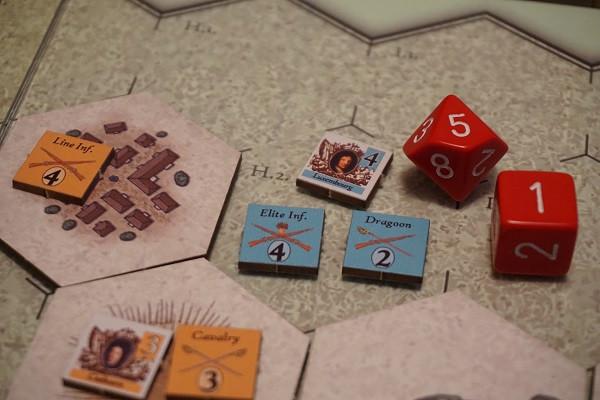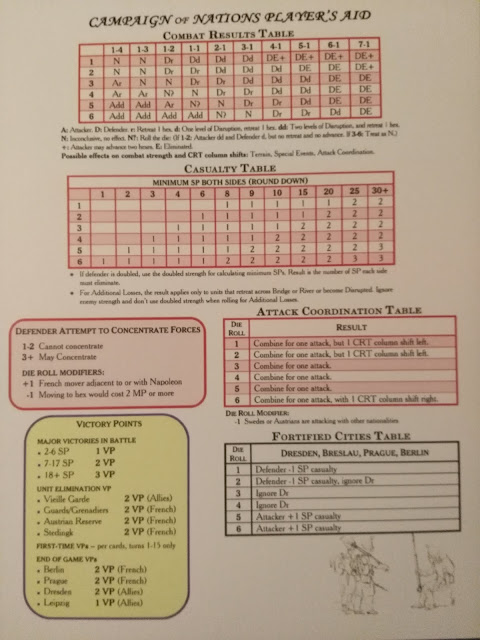I normally only have one game at a time set up, that is until Horse and Musket showed up at my door. I had to figure out a way to set it up and play it. For those of us who are interested in the wars of Louis XIV, this is almost the Holy Grail. The campaigns and battles of Marlborough during the War of The Spanish Succession have had a lot of games designed about them (I should know I own almost all of them). Some games even allow you to fight battles from earlier in the Sun King's reign. This game allows you to fight battles from 1683 until 1720. So this includes the Nine Years' War or the War of The Grand Alliance. This war was fought from 1688-1997. What this means is that you can now refight the battles of French Marshals Catinat and Luxembourg. The game actually allows you to start your tour of the Horse and Musket era in 1683 and fight to save or keep besieging Vienna during the Ottoman's last gasp toward conquering Europe. This is a list of the battles included:
Vienna - September 12, 1683 – “We came, we saw, and God Conquered.”
Sedgemoor - July 6, 1685 – The Bloody Assizes
Killiecrankie - July 27, 1689 – Slaughter at Sundown
Fleurus - July 1, 1690 – The French Cannae
Aughrim - July 22, 1691 – Bloody Hollow
La Prairie - August 11, 1691 – Double Ambush
Neerwinden - July 29, 1693 – Le Tapissier de Nôtre Dame
Marsaglia - October 4, 1693 – The Massed Bayonet Charge is Born
Narva - November 30, 1700 – Charles XII Smashes the Russian Army
Chiari - September 1, 1701 – Catinat’s Last Battle
Klissow - July 19, 1702 – Charles XII Invades Poland
Blenheim - August 13, 1704 – “A Famous Victory”
Fraustadt - February 13, 1706 – The Swedish Cannae
Turin - September 7, 1706 – Eugene’s Greatest Victory
Almansa - April 25, 1707 – Battle of the Exiles
Poltava - July 8, 1709 – The Student Surpasses the Master
Malplaquet - September 11, 1709 – Mort et convoi de l'invincible Malbrough
Villaviciosa - December 10, 1710 – A Bourbon on the Spanish Throne
Sheriffmuir - November 13, 1715 – Confusion on the Moors
Glen Shiel - June 10, 1719 – Rob Roy’s Last Battle
The map for the game is 16"x 32". It is a 'blank slate'
type of map. To represent the different battles, there are geomorphic
tiles to be used in the hexes. So this allows the player to be creative
and make up his own scenarios once he has played through the ones that
come with the game. To me, the geomorphic tiles have an old type style to them that sets the tone for the game.
The
game comes with a 15 page rule book. It also comes with a 27 page
scenario booklet. At the end of the scenario booklet are 6 pages of
historical notes on the battles and the era.
The
core rules are only 10 pages long. To these are added another 38 optional
rules. Some of these are listed 'highly recommended'. Then there are
ones that are 'strongly recommended'. This is the funny yet entirely
true warning before the optional rules:
"STOP! NO, SERIOUSLY READ THIS
You've reached the end of the core rules. What follows are Optional Rules. For your first few games, please use the core rules only. I know almost every rulebook says this, and you ignore that and jump right in for the 'real stuff', but we really mean it this time. Once you've gotten a grip on the core rules, you can add one or more of the thirty-eight optional rules that follow."
This is a list of the units that you get to command:
Elite infantry
Line infantry
Light infantry
Militia
Cavalry
Hussar
Dragoon
Native
Irregular
Highlander - these ones are not immortal
Artillery
Leaders
The game turn sequence is:
1.
Player A rolls and determines random action points available and adds
to the Command Action Points and stored Action Points for his total.
2. Player A spends Action Points one at a time and performs allowable actions in any order he wishes.
3. Check Victory
4.
Player B rolls and determines random Action Points available and adds
to the Command Action Points and stored Action Points for his total.
5. Player B spends Action Points one at a time and performs allowable actions in any order he wishes.
6. Check Victory
7. End turn - move turn marker ahead one space on CAP Track, and go back to step 1.
So along with Marshal Luxembourg you get to try and do better than Charles XII, Marlborough, Villars, and Prince Eugene. If it was a movie what a cast you would have!

The game uses very few pieces to represent the forces in each battle. This might be a turn off to some gamers who love to see their army all lined up and taking up most of their side of the map. To me, the small number of counters mean that you will have to spend much less time to set up the game and start playing. I don't think that the low counter use detracts from the game play either. There are still a multitude of tactics and plans that you can come up with to win your battle. Once you are set with the rules and start using the optional ones is when the game really shines. It gives the player the feel of fighting battles in the 17th and 18th century. I would say that the game is easy to play and not simple. There is a really big difference between the two. I have played a few of Mr, Chick's games, and I am a real fan. It is not just because of the time period, but I am also a fan of the games' designs and mechanics.
Robert














Follow Us